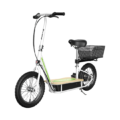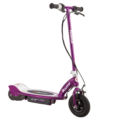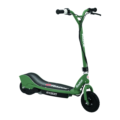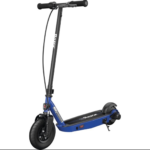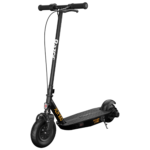- Home
- Scooters
- Electric Scooters
- Razor Power Core XLR90
Razor Power Core XLR90
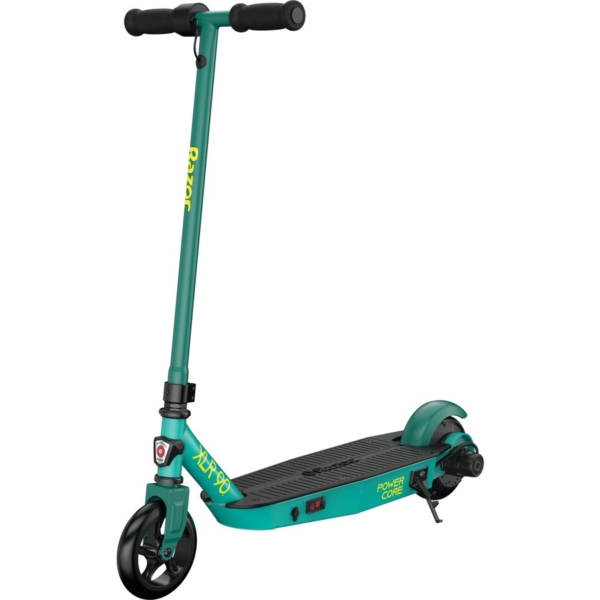

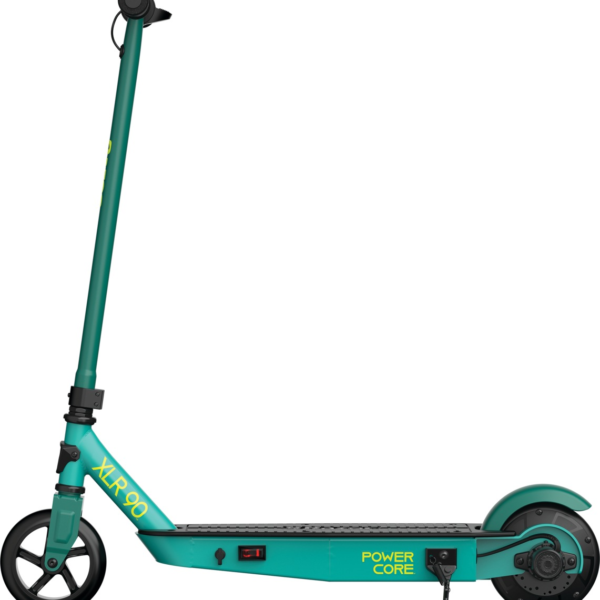

- Battery Range: 9 mi (14 km)
- Top Speed: 10 mph (16 km/h)
- Motor Power: 90 W nominal
- Weight Capacity: 132 lb (60 kg)
- Charging Time: ~4–5 h
- Scooter Weight: 21.0 lb (9.5 kg)
PROS
- Kid-friendly speed and controls
- Low-upkeep hub motor
- LED styling to boost visibility
- Lightweight for easy carry
- Solid tires resist flats
CONS
- Not for adult riders
- Shorter range
- No suspension
- Lower weight capacity
Table of contents
- What Is the Razor Power Core XLR90?
- How the Razor Power Core XLR90 Works
- Key Specifications
- Design & Build Quality
- Performance Fundamentals
- Battery, Range & Efficiency
- Ride Quality & Comfort
- Braking & Safety Features
- Portability & Daily Usability
- Maintenance & Care
- Weather & Seasonal Considerations
- Razor Power Core XLR90 vs Alternatives
- Who the Razor Power Core XLR90 Is (and Isn’t) For
- FAQs
- Glossary
The Razor Power Core XLR90 is a simple, sturdy, and beginner-friendly electric scooter designed for short hops, school runs, and around-the-neighborhood rides. It favors durability and low-maintenance parts over fancy features, which keeps ownership easy for new riders. Because it uses a straightforward drivetrain and controls, it suits families who want “charge, hop on, and go” convenience without a steep learning curve.
What Is the Razor Power Core XLR90?
The Razor Power Core XLR90 sits in the entry-level class of electric scooters. It prioritizes simplicity and predictable handling rather than raw speed or long distance. In practice, that means steady acceleration, modest top speed, and an emphasis on safety basics like reliable braking and a stable stance. Most riders use it for quick errands, short commutes to school or activities, or a last-mile hop from public transit. As a result, it’s a solid fit for younger riders and new adults who want a dependable first scooter that won’t demand constant tinkering.
Crucially, the XLR90’s design is uncomplicated. The hub motor is sealed. The control electronics are tucked away from the elements. The deck is robust and usually topped with a grippy surface to keep shoes planted. Because the package is simple, regular care is straightforward: check a few bolts, charge the battery correctly, and store it smartly between rides. That routine keeps performance consistent, especially when temperatures swing or roads get damp.
Although this model is basic, it still delivers the core joys of scootering: zippy starts from a stop sign, easy carving down smooth paths, and nimble weaving through neighborhood streets. If you value a predictable ride and a light maintenance burden, the XLR90 delivers that balance.
How the Razor Power Core XLR90 Works
Motor
The XLR90’s motor is integrated into the rear wheel. This “hub motor” design is quiet and efficient because there are no external chains or belts to adjust. Power flows directly to the wheel, which reduces mechanical losses and keeps the drivetrain clean. For new riders, the benefit is immediate: fewer parts to maintain and a consistent push from the motor when you roll on the throttle.
Controller
Between your thumb and the motor sits the controller. Think of it as the scooter’s brain. It interprets throttle input, meters battery power, and protects the system from overloads. Because it’s sealed and pre-tuned, there are no user adjustments to worry about. The result is a predictable response that helps riders learn smooth control.
Battery
A rechargeable battery inside the deck powers the system. Capacity is sized for short trips and play sessions rather than all-day adventures. Because range depends on rider weight, terrain, temperature, and speed, you’ll see the best results on smooth, flat paths and moderate cruising. Proper charging habits matter, too. As a rule of thumb, avoid deep discharges, give the pack time to cool before charging after a long ride, and store it in a dry, moderate-temperature room.
Throttle
The throttle is intentionally simple. Many entry-level scooters use a single-mode or on/off-style control. Others offer a progressive “more press, more power” feel. In either case, the goal is easy modulation without surprises. New riders should practice gradual inputs in an open area. That habit builds muscle memory and helps you maintain traction on dusty or slightly wet surfaces.
Brakes
Braking is equally straightforward. Most units in this class rely on a rear fender brake and/or an electronic cut-off that reduces power as you slow. The technique stays the same: shift your weight slightly rearward, apply the brake smoothly, and look ahead to where you want to stop. Because entry-level scooters often skip advanced hydraulic systems, smooth inputs make a big difference in stopping distance and balance.
Key Specifications
These details reflect the typical configuration for an entry-level Razor Power Core model in this class. Exact equipment can vary by production run and region.
| Block | Item | Detail |
|---|---|---|
| General | Model | Razor Power Core XLR90 |
| Intended Use | Short trips, school runs, neighborhood rides | |
| Rider Focus | Beginners, students, casual commuters | |
| Drivetrain | Rear hub motor (sealed) | |
| Frame Material | Steel or alloy blend with reinforced deck | |
| Performance & Power | Ride Mode | Single, beginner-friendly tuning |
| Acceleration | Predictable, steady pull from a stop | |
| Hill Behavior | Handles gentle grades; slows on 7–10% hills | |
| Noise | Low mechanical noise; quiet motor whir | |
| Battery, Charging & Electrical | Battery | Rechargeable pack housed in deck |
| Charger | Smart charger with indicator light | |
| Charge Routine | Avoid deep discharge; cool before charging | |
| Electrical Protection | Controller manages current and thermal limits | |
| Build & Dimensions | Deck | Grippy surface; space for a stable stance |
| Stem | Fixed stem tuned for entry-level stability | |
| Folding | Non-folding frame on most units | |
| Folded Dimensions | Not applicable on non-folding variants | |
| Weight Class | Lightweight, easy to maneuver by hand | |
| Safety & Control | Brakes | Rear fender and/or electronic power cut-off |
| Lighting | Basic front/rear lights or reflectors (varies by unit) | |
| Traction | Solid tires favor smooth pavement | |
| Water Resistance | Light splash resistance; avoid heavy rain | |
| Features & Extras | Controls | Simple throttle and power switch |
| Display | Minimal indicator LEDs (varies by unit) | |
| Cruise Control | Typically not included in this class | |
| Warranty & Compliance | Warranty | Limited manufacturer coverage; terms differ by region |
| Compliance | Meets typical consumer e-mobility safety norms |
Design & Build Quality
The XLR90’s frame favors ruggedness over complexity. The main tubes resist dents from casual knocks, while welds are positioned to handle repeated curb drops and driveway transitions. Because the motor lives in the rear wheel, there’s no chain slap or belt whine. That keeps the scooter quiet and reduces the chance of grease getting on shoes or clothes.
On the deck, riders will find grippy material that works with everyday sneakers. The deck length suits a natural stance with the front foot angled slightly outward and the rear foot near the fender. That posture keeps the knees bent and the center of gravity low, which helps the scooter remain calm over expansion joints and patched tarmac.
The stem is tuned for entry-level stability. It’s not designed for extreme speeds, yet it resists twangy flex as you weave through tight spaces. The cockpit is intentionally sparse. There’s a power switch, a throttle, and sometimes a small indicator LED. Because there are fewer parts, there’s less to rattle loose. That restraint also helps families who want to hand the scooter to different riders without a five-minute setup ritual.
Fit-and-finish details matter. On the XLR90, cable runs are tidy and tucked, the deck edges are smooth, and the brake hardware is easy to inspect. Those touches make quick pre-ride checks simple, which encourages safe habits and keeps the scooter feeling tight as miles accumulate.
Performance Fundamentals
Acceleration Feel
From a stop, the XLR90 pulls with a steady, confidence-building push. It doesn’t lurch. Instead, power rises predictably as you press the throttle. That smoothness helps new riders learn to balance small steering inputs with speed changes. On clean asphalt, the tire compound grips well, so the scooter tracks straight without surprising wheelspin.
Cruising Stability
Once rolling, the chassis feels composed. Because the stem and deck geometry target beginner stability, the scooter avoids twitchy steering. You can ride one-handed briefly to adjust a glove or backpack strap, though you should always keep both hands on the bars when possible. On smoother paths, the ride feels planted. On rougher patches, the solid-tire feedback reminds you to ease your speed slightly.
Hill-Climb Behavior (≈7–10% Grades)
Gentle hills are fine. Moderate grades require patience. At a 7–10% slope, the XLR90 slows but continues to climb if you maintain a steady throttle and a forward-leaning posture. Because power is tuned for beginners, you’ll trade speed for control. If you ride hills daily, keep your cadence consistent and avoid abrupt throttle chops, which can break traction on dusty surfaces near the crest.
Battery, Range & Efficiency
Range is the most misunderstood part of any scooter. The XLR90’s battery is sized for short rides, yet real-world distance depends heavily on conditions. A lighter rider on flat ground will see longer range. A heavier rider on hilly routes will reach the battery’s limit sooner. Additionally, cold weather temporarily reduces usable capacity, while headwinds increase energy draw.
To maximize efficiency, ride at a steady pace instead of sprinting between stops. Coast early toward stop signs. Keep the deck clear of heavy accessories. Because the controller meters current to protect the pack, the scooter still feels consistent across most of a charge. Near empty, expect a softer pull as the system conserves energy.
Charging Best Practices
- Cool, then charge. After a long ride, let the scooter rest until the deck feels room-temperature.
- Partial charges are fine. Topping up before a short trip helps avoid deep discharges.
- Storage habits matter. Store at moderate room temperature and avoid full empty for long periods.
- Use the included charger. It’s matched to the scooter’s pack and control system.
- Check the indicator. Most chargers signal status. Unplug after a full charge.
Those habits protect the battery and keep day-to-day range more consistent across seasons.
Ride Quality & Comfort
The XLR90 leans on solid tires and a rigid frame. That choice resists flats and reduces maintenance, but it also transmits more texture from the road. On smooth asphalt or polished paths, the ride feels clean and controlled. On broken pavement, you’ll notice buzz through the bars and deck.
Because there’s no suspension to mask large bumps, your stance matters. Keep knees and elbows slightly bent. Shift weight to your legs on rough patches rather than bracing through locked arms. That technique absorbs impacts and keeps the front wheel tracking where you point it.
Ergonomics are friendly for new riders. Bar height works for a range of users, and the bar width offers leverage without feeling wide for doorways and bike racks. The deck grip holds up well in dry conditions. In light mist, wipe it before riding to maintain traction underfoot.
Braking & Safety Features
The braking system is simple by design. A rear fender brake leverages body weight over the wheel to slow the scooter, while an electronic cut-off typically reduces motor assistance as you brake. Because these systems are basic, technique is important. Look ahead, brake early, and keep your weight centered. On slick leaves or fine gravel, squeeze braking inputs rather than stamping on the fender.
Lighting varies by unit and region. Many entry-level models include reflectors and a basic front/rear light. Even so, dusk riding demands caution. Wear a light-colored top or a reflective strap. Ride defensively near driveways and parked cars, because drivers often expect bicycles, not compact scooters.
Water resistance is designed for light splashes. Avoid standing water, deep puddles, and driving rain, which can hide potholes and stress seals. If you do encounter spray, dry the scooter after the ride and let it air out before charging.
Portability & Daily Usability
The XLR90 is easy to move around the garage or a hallway because it’s compact and relatively light for an electric scooter. Many units in this family do not fold; the fixed stem keeps the structure simple and rattle-free. That means storage works best against a wall, under a desk, or in a closet.
For carrying, grip the stem near the clamp area and keep the deck pointed slightly downward. That angle prevents the rear wheel from bumping your legs. Because the scooter is small, it fits in most car trunks if you clear space first. At school or work, a simple cable lock through the frame and a fixed post helps deter casual tampering. Do not leave it outside overnight, since moisture and temperature swings reduce battery life.
Daily rituals are quick. Turn it on, check the deck for debris, and take a slow lap to confirm smooth rolling and normal brake feel. After the ride, power off and wipe any visible dust. Those small habits extend the scooter’s useful life and reduce surprises.
Maintenance & Care
Maintenance is light yet important. Here’s a simple schedule that works well for families:
Before every ride
- Quick visual scan: deck, bars, brake hardware, and rear wheel.
- Press the throttle briefly while the rear wheel is off the ground; confirm smooth spin.
- Squeeze the brake to verify firm, centered action.
Every two weeks
- Check fasteners at the stem clamp and brake mount for snugness.
- Inspect tire tread and surface for embedded stones or cracks.
- Clean the deck grip with a damp cloth and let it dry fully.
Monthly
- Deep clean: remove dust from the controller area vents or cover.
- Inspect cable runs for chafe points; add a small piece of protective tape if needed.
- Evaluate brake wear and alignment; adjust the fender return spring if it drags.
Seasonally
- Battery care: if storing for more than a month, charge to a middle state and unplug.
- Thorough bolt check with a proper tool (do not overtighten).
- Replace worn grips if they feel slick in the rain.
Because the XLR90 omits complex suspension or hydraulic components, these basics cover nearly everything a typical owner will face.
Weather & Seasonal Considerations
Rain
Light mist is manageable with caution. However, heavy rain and deep puddles are not recommended. Wet roads lengthen stopping distances and reduce tire grip. Lower your speed, avoid paint lines and metal plates, and brake earlier than usual.
Heat
High temperatures reduce motor and battery efficiency slightly. Store the scooter in the shade, and allow it to cool before charging after a long, hot ride. If the deck feels hot to the touch, take a short break.
Cold
Cold weather temporarily reduces battery output and range. Plan shorter routes and keep speeds steady. After a winter ride, let the scooter warm to room temperature before charging. That practice protects the pack and restores normal performance.
Wind
Headwinds increase energy draw. Tuck elbows, keep your stance compact, and avoid full-throttle blasts into strong gusts. Crosswinds can nudge the stem. Therefore, keep your knees relaxed and your eyes farther up the road to anticipate corrections.
Razor Power Core XLR90 vs Alternatives
The Razor Power Core XLR90 shines when simplicity and durability matter more than speed or long range. Against commuter-class models, it trades features like app integration, turn signals, or multiple ride modes for a “just ride” experience. That’s helpful for families who share the scooter or for riders who prefer minimal controls.
Versus Budget Commuters
Entry-level commuters usually add a folding joint and a longer deck to suit daily transit. They may ride a bit smoother on mixed pavement and offer slightly more range. However, they also introduce more parts to adjust and more weight to carry upstairs. If your routes are truly short and your storage is tight, the XLR90 remains easier to live with.
Versus Performance Models
Performance scooters deliver faster acceleration, higher top speeds, and multi-mode control. They also demand more rider skill and maintenance. For beginners or younger riders, that’s often unnecessary. The XLR90’s predictable behavior helps riders learn fundamentals safely before stepping up.
Versus Off-Road Scooters
Off-road machines use wide pneumatic tires and suspension that soaks up ruts. They are heavier, more expensive, and harder to store. Unless you regularly ride gravel paths or forest trails, an off-road platform is overkill. The XLR90 is happier on paved paths and neighborhood streets where its compact footprint excels.
In short, choose the XLR90 when you value easy ownership, quick storage, and reliable short-trip performance. Choose a commuter or performance model when you consistently ride longer distances, need higher speed, or carry heavier loads.
To see a comparable, entry-level build from the same family, the Razor Power Core E90 demonstrates the same low-maintenance approach with beginner-focused tuning.
Who the Razor Power Core XLR90 Is (and Isn’t) For
Great for:
- Students riding to school, practice, or a part-time job.
- Parents who want a low-maintenance household scooter for quick errands.
- New riders who prioritize predictable control over speed and features.
- Multi-modal travelers who need a compact last-mile option from bus or train.
Not ideal for:
- Long daily commutes where range anxiety becomes a constant worry.
- Riders who want suspension comfort on broken pavement.
- Speed enthusiasts who expect rapid acceleration or high top speed.
- Regular off-road use, gravel riding, or wet-weather adventures.
If you match the first list more than the second, the XLR90’s design choices will likely feel right at home.
FAQs
1) How fast does it feel in everyday use?
It feels brisk from neighborhood starts and calm at cruising pace. Because the power is beginner-friendly, you get steady pull rather than a sudden surge.
2) Can the XLR90 handle hills?
Yes, gentle hills are fine. On 7–10% grades, expect a slower climb. Keep a steady throttle and a forward-leaning posture for best traction.
3) What tires does it use?
Most units in this class use solid tires for low maintenance. They resist flats but ride firmer than air-filled tires, so reduce speed on rough patches.
4) How should I charge it?
Let the scooter cool to room temperature after a long ride, then use the included charger until the indicator shows full. Avoid deep discharges and store at moderate temperatures.
5) Is there a “Razor Power Core XLR90 overview” I can skim?
Yes. You’re reading a complete overview that explains design, ride feel, care, and who it suits.
6) Does it fold?
Most units are non-folding. That reduces rattles and maintenance. For storage, stand it against a wall or tuck it under a desk.
7) What safety steps matter most?
Do a quick pre-ride check, ride slower in the wet, brake early, and wear visible clothing at dusk. Keep the deck clean for better shoe grip.
Glossary
- Ah (Amp-hour): A measure of battery capacity. More Ah generally means longer potential run time.
- Wh (Watt-hour): Battery energy (voltage × capacity). It’s a better single number for total energy than Ah alone.
- Controller: The electronic brain that meters power from battery to motor based on throttle input and safety limits.
- Hub Motor: A motor built into the wheel hub. It’s quiet, efficient, and low maintenance.
- Regen (Regenerative Braking): A system that feeds small amounts of power back to the battery during braking. Entry-level models may use simple electronic cut-off instead.
- Stem Flex: The small, elastic movement you feel in the handlebar stem under load. Some flex is normal; excessive flex feels wobbly.
- IP Rating: Ingress Protection rating against dust and water. Entry-level scooters often have light splash protection rather than a formal rating.
- Solid Tire: A puncture-resistant tire that doesn’t use air. It reduces flats but rides firmer than pneumatic tires.
- Pneumatic Tire: An air-filled tire that improves comfort and grip but can puncture.
- Throttle: The control that requests power from the motor. It may be a button or a lever with progressive response.
- Cut-Off: Electronic reduction of motor power during braking or when faults are detected.
- Deck Grip: The textured surface on the deck that helps your shoes stay planted.
- Charge Cycle: One full discharge and recharge of the battery. Good habits extend useful cycles.
- Grade: The steepness of a hill, often expressed as a percentage.
- Rider Posture: Your stance, weight distribution, and arm/knee bend that influence comfort and control.
Specifications
General
| Model The Model specifies the exact version or name of the scooter. It helps identify its unique design, features, and specifications within the manufacturer’s product line. Knowing the model makes it easier to compare options, find compatible accessories, or look up support information. | Power Core XLR90 |
| Brand The Brand identifies the manufacturer or company that designs and produces the scooter. A trusted brand is a sign of quality, reliability, and good customer support. Well-known brands often have higher standards for safety, performance, and after-sales service, giving you more confidence in your purchase. | Razor |
| Release Date The Release Date indicates when the scooter model was officially launched on the market. This helps you know how current the design, technology, and features are. A newer release date often means updated components, improved performance, and the latest safety or smart features. | 17 November 2025 |
| Recommended Age Recommended Age indicates the minimum age range that the scooter is designed for, based on safety, size, and ease of use. Following the recommended age helps ensure that riders can handle the scooter’s speed, weight, and controls comfortably and safely. Always check local laws and use protective gear, especially for younger riders. | Recommended 8+ |
Performance & Power
| Motor Power (Wattage) What it means: The motor power, measured in watts (W), shows how strong the scooter’s electric motor is. Why it matters: Higher wattage usually means better acceleration, more torque, and improved performance on hills or rough terrain. For example, a 250W motor is good for flat city roads and light riders, while a 500W or 1000W motor provides more power for faster speeds or climbing steep inclines. | 90 W nominal (Power Core) |
| Top Speed The Top Speed indicates the maximum speed that the scooter can reach under optimal conditions. It’s usually measured on level ground with a fully charged battery and an average rider weight. A higher top speed allows you to travel longer distances faster, but always ensure you ride within legal speed limits and your personal comfort zone for safety. | 10 mph (16 km/h) |
| Battery Capacity Battery Capacity refers to the total amount of energy the scooter’s battery can store, usually measured in ampere-hours (Ah) or watt-hours (Wh). A higher battery capacity means you can ride longer distances on a single charge, reducing the need for frequent recharging. Keep in mind that actual range can vary depending on rider weight, terrain, speed, and weather conditions. | 12–24 V 5 Ah class |
| Estimated Range per Charge The Estimated Range per Charge indicates the average distance the scooter can travel on a single full battery charge. This range is calculated under optimal conditions, such as flat terrain, moderate speed, and average rider weight. Real-world range may vary depending on riding style, terrain, weather, and load. A longer range means fewer recharges and greater freedom for longer trips. | Up to 9 mi (14 km) |
| Hill Climb Ability Hill Climb Ability describes the maximum incline or slope that the scooter can handle while maintaining stable performance. It’s typically expressed as a percentage or in degrees. A higher hill climb rating means the scooter can tackle steeper hills without losing too much speed or power. Actual climbing performance may vary based on rider weight, battery charge, and terrain conditions. | Gentle slopes |
| Drive System The Drive System refers to how power from the motor is delivered to the wheels. Electric scooters typically use either a hub motor (directly integrated into the wheel) or a chain/belt drive system. A high-quality drive system ensures smooth acceleration, efficient power transfer, and low maintenance. The choice of drive system affects performance, noise level, and overall ride experience. | Rear hub motor (RWD) |
Charging & Electrical
| Charging Time Charging Time indicates how long it takes to fully recharge the scooter’s battery from empty to 100% using the standard charger provided. Faster charging means less downtime and more time on the road. Actual charging time may vary slightly depending on battery capacity, charger output, and environmental conditions. | Approx. 4–5 hours |
| Battery Type Battery Type refers to the specific technology used in the scooter’s battery, which affects performance, lifespan, weight, and charging time. Most modern electric scooters use high-quality lithium-ion (Li-ion) batteries because they offer a good balance of energy density, durability, and low maintenance. A reliable battery type ensures consistent power delivery and longer riding ranges. | Li-ion with basic BMS |
| Removable Battery A Removable Battery means the battery pack can be easily detached from the scooter for convenient charging and replacement. This feature allows you to charge the battery separately, swap it with a spare for extended range, or securely store it indoors in extreme weather. Removable batteries add flexibility and make it easier to keep your scooter powered up wherever you are. | No external fast charge |
| Regenerative Braking Regenerative Braking is an energy-saving feature that converts some of the energy normally lost during braking back into battery power. When you slow down or brake, the motor works in reverse to generate electricity, which helps extend the scooter’s range and improves overall efficiency. This system also reduces wear on traditional brake components, leading to lower maintenance over time. | Electronic front assist |
| Lighting Lighting refers to the built-in front and rear lights that enhance visibility and safety when riding in low-light conditions or at night. Good lighting helps you see the road ahead and ensures that other road users can see you. Many scooters include LED headlights, taillights, and sometimes brake lights or side reflectors for added safety and compliance with local traffic regulations. | Headlight/LEDs + reflectors |
Build & Dimensions
| Scooter Weight Scooter Weight refers to the total weight of the scooter when fully assembled, including the battery. This affects how easy it is to carry, lift, and store the scooter when not in use. A lighter scooter is more portable and convenient for commuting, especially if you need to carry it upstairs or onto public transport. Keep in mind that a sturdy frame and quality components may add to the weight but also contribute to better durability and ride stability. | 21.0 lb (9.5 kg) |
| Maximum Rider Weight Maximum Rider Weight indicates the highest rider weight that the scooter is designed to safely support while maintaining optimal performance and stability. Staying within this limit helps ensure reliable acceleration, braking, and climbing ability, and it protects the frame, suspension, and motor from excessive strain. Exceeding the recommended limit may reduce performance and increase wear on components. | 132 lb (60 kg) |
| Deck Size Deck Size refers to the dimensions of the scooter’s standing platform. A wider and longer deck provides more foot space, allowing you to stand comfortably and adjust your stance while riding. A well-sized deck improves balance and stability, especially on longer rides or at higher speeds. Compact decks, on the other hand, help keep the scooter lightweight and portable. | Low deck; narrow stance |
| Handlebar Height Handlebar Height refers to the distance from the deck to the handlebars, which affects your riding posture and comfort. An appropriate handlebar height helps you maintain good balance, reduces strain on your back and arms, and makes steering more comfortable. Some scooters have adjustable handlebars to fit riders of different heights, while others have a fixed height for a streamlined design. | Kid-height bars |
| Folding Mechanism The Folding Mechanism describes how easily and securely the scooter can be folded for carrying and storage. A well-designed folding system lets you quickly collapse the scooter into a compact size, making it convenient to transport on public transit, store under a desk, or fit into a car trunk. Look for sturdy latches and safety locks to ensure the scooter stays firmly in place when folded or unfolded. | Simple folding latch |
| Dimensions Folded Dimensions indicate the size of the scooter when it’s fully folded. This measurement shows how much space the scooter will take up when stored or carried, making it easier to check if it will fit in your car trunk, under a desk, or in a closet. Compact folded dimensions are ideal for commuters who need to bring their scooter on public transport or store it in tight spaces. | 36.5 × 14.0 × 15.5 in (folded) |
| Material Material refers to the primary construction materials used for the scooter’s frame and key components. High-quality materials like aircraft-grade aluminum, reinforced steel, or durable composites provide strength, stability, and a lighter overall weight. A sturdy material ensures the scooter can handle daily wear and tear while maintaining safety and performance. | Aluminum/steel mix |
Safety & Control
| Brake Type(s) Brake Type(s) describe the braking systems the scooter uses to help you slow down or stop safely. Common brake types include mechanical brakes (like drum or disc brakes), electronic brakes, and foot brakes. Many scooters combine multiple braking systems for added safety and shorter stopping distances. The type and quality of brakes affect your control, especially when riding at higher speeds or on slopes. | Front electronic + rear foot |
| Suspension Suspension refers to the system that absorbs shocks and vibrations while riding, providing a smoother and more comfortable ride over uneven or rough surfaces. Scooters may have front suspension, rear suspension, or dual suspension for better shock absorption and stability. Good suspension helps reduce rider fatigue and improves control, especially when riding on bumpy roads or off-road paths. | None |
| Tire Type Tire Type refers to the kind of tires the scooter uses, which directly affects ride comfort, traction, and maintenance. Common types include solid (airless) tires, pneumatic (air-filled) tires, or hybrid options. Pneumatic tires offer better shock absorption and a smoother ride on rough surfaces, while solid tires are puncture-proof and require less upkeep. The right tire type helps ensure safe handling and a comfortable ride in different conditions. | Urethane/TPU solid |
| Tire Size Tire Size indicates the diameter and width of the scooter’s tires, which affect ride comfort, stability, and how well the scooter handles different terrains. Larger tires generally offer better shock absorption and a smoother ride over bumps and rough surfaces, while smaller tires keep the scooter lighter and more portable. Choosing the right tire size helps ensure a balance between agility and comfort. | 6–7 inch class |
| Kickstand The Kickstand is a built-in stand that allows you to park your scooter upright when it’s not in use. A sturdy kickstand keeps the scooter stable and prevents it from tipping over, protecting it from scratches and damage. It also makes storing and accessing your scooter more convenient, whether you’re at home, work, or on the go. | Side kickstand |
| Water Resistance Rating Water Resistance Rating indicates how well the scooter is protected against water and moisture, usually shown as an IP (Ingress Protection) rating. This rating helps you understand whether the scooter can handle light rain, splashes, or wet roads without damage. While most scooters are not fully waterproof, a good water resistance rating adds peace of mind when riding in changing weather conditions. Always avoid deep puddles or submerging the scooter to protect its electrical components. | IPX4 body |
Features & Extras
| Display/Console The Display (or Console) shows important real-time information about your ride, helping you monitor your scooter’s status at a glance. Typical displays show speed, battery level, distance traveled, and riding mode. Some models also include additional features like Bluetooth connectivity, app integration, or backlighting for better visibility at night. A clear and easy-to-read display enhances safety and convenience on every trip. | LED dashboard |
| Ride Modes Ride Modes refer to the different speed and power settings you can choose to match your riding style or road conditions. Common modes include eco for maximum range and energy efficiency, standard for everyday balance, and sport or turbo for higher speed and stronger acceleration. Switching between ride modes allows you to customize performance, conserve battery, and ride safely in various environments. | Beginner, Standard |
| Smart App Connectivity Smart App Connectivity lets you pair your scooter with a dedicated mobile app via Bluetooth. Using the app, you can monitor real-time ride stats like speed, battery level, and range, adjust settings such as ride modes or cruise control, lock the scooter for added security, and sometimes receive firmware updates. This feature adds convenience and allows you to personalize your riding experience right from your smartphone. | App-free basic operation |
| Anti-Theft System The Anti-Theft System helps protect your scooter from unauthorized use or theft. This feature can include built-in alarms, electronic motor locks, GPS tracking, or remote locking through a mobile app. A good anti-theft system provides peace of mind when parking your scooter in public spaces, adding an extra layer of security to safeguard your investment. | N/A |
| Cruise Control Cruise Control allows you to maintain a steady speed without continuously holding the throttle. This feature makes longer rides more comfortable by reducing hand fatigue and providing a smoother, more relaxed riding experience — especially on flat, open roads or bike lanes. For safety, cruise control can usually be easily activated or deactivated while riding. | No (region-dependent) |
| Accessories Included Accessories Included lists the additional items that come with the scooter to enhance your riding experience and convenience. Common accessories may include a charger, kickstand, bell, lights, phone holder, or carrying strap. These extras add value by making your scooter safer, easier to use, and ready to ride straight out of the box. | Bell, reflectors, charger |
Warranty & Compliance
| Warranty Period The Warranty Period indicates how long the manufacturer guarantees the scooter against defects in materials and workmanship under normal use. A good warranty provides peace of mind, showing the brand’s confidence in its product quality. Always check what parts are covered, such as the frame, battery, and motor, and follow the maintenance guidelines to keep your warranty valid. | 12 months typical |
| Certifications Certifications confirm that the scooter meets specific safety, quality, and environmental standards set by recognized organizations or regulatory bodies. Common certifications may include CE, RoHS, UL, or other local compliance marks, depending on your region. These certifications ensure that the scooter is manufactured to high standards and is safe and legal to use in your country. | Local e-scooter compliance |


